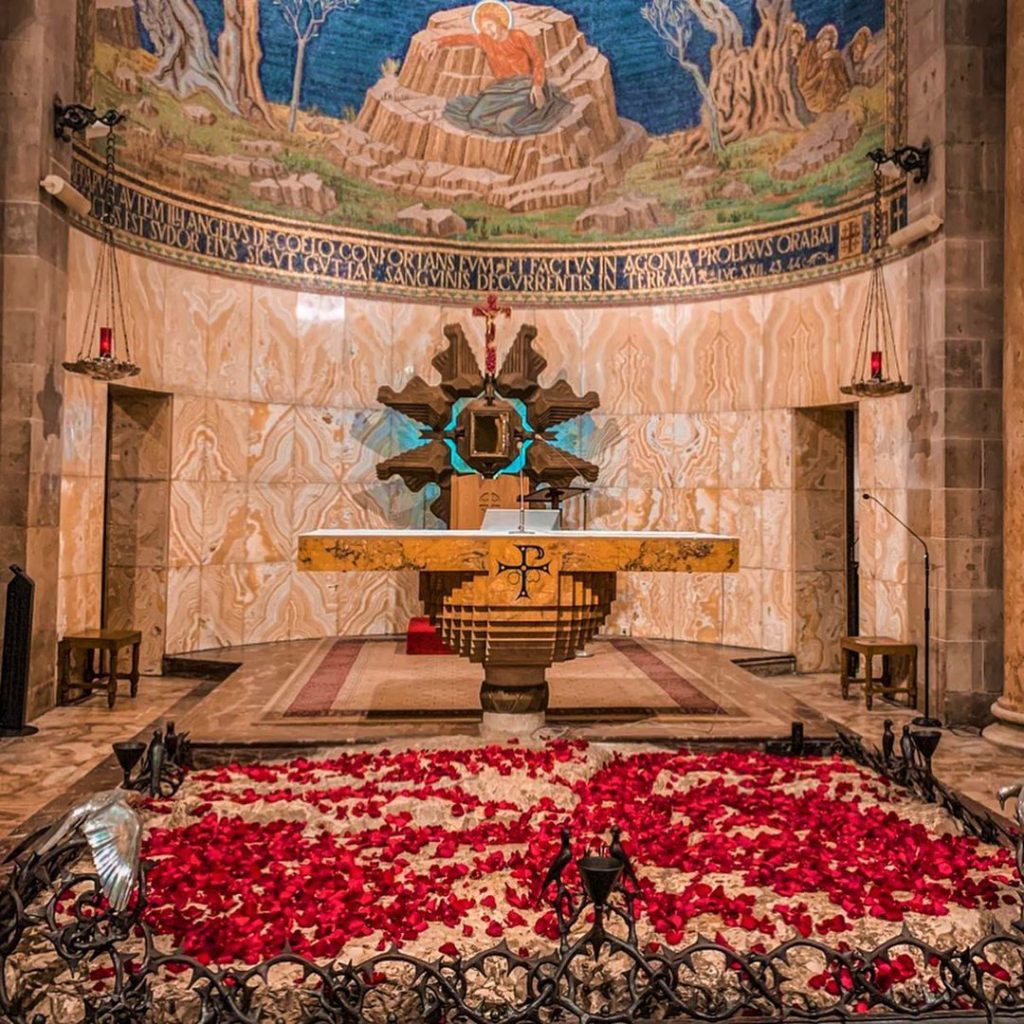The story of Jesus’ last hours begins at the Garden of Gethsemane. Here, on a dark Thursday night, begins his passion, in that frightful agony wherein the God-Man almost seemed to have been rejected by his Father even as he was neglected by his sleeping Apostles. And here, too, strengthened at the end of his Agony, Jesus confronts his enemies. Betrayed by Judas Iscariot, one of his closest followers, arrested like a thief in the night.
Christian tradition has held in veneration a particular spot identified as Gethsemane. It’s marked these days; As in past centuries; Both by a beautiful basilica and by a small grove of olives trees. Tradition says they are offshoots of the trees that witnessed Jesus’ Agony.
Once inside the garden, Jesus turned to the right of the Apostles and said to them:
“Sit down here while I go over yonder and pray.”
(Matt. 26:36)
Taking Peter and James and John with him, he went a little further into the interior of the garden. Already beginning to feel the first onslaughts of fear and sadness, he said to the favored three:
“Wait here and watch with me.”
(Matt. 26:38)
In Gethsemane, we come face to face with Christ’s sadness and trouble of mind; his timidity and hesitation; his prayer, repeated over and over as he lay prostrate on the ground; the apparent contradiction between his will and that of his Father; his seeming cowardice in the face of death; his weakness and agony and bloody sweat.
More About the Last Hours of Jesus
There are several reasons why Jesus chose Peter, James, and John to accompany him. They had been specially selected witnesses of the raising to life of the daughter of Jairus (Mark 5:37) as well as of the transfiguration of Jesus. (Mark 9:2). They were, among the Twelve Disciples, his inner circle; the Apostles Jesus loved the most and from whose presence he hoped to receive the most comfort during his time of supreme trial. Jesus had even instructed the Apostles to pray:
“Pray that you may not enter into temptation.”
(Luke 22:40)
The terrible events which would put them to the test were now taking shape in the darkness of the nearby city, and Jesus warned them to pray that they might have the strength to pass safely through the ordeal. After Jesus had confided his sorrow of soul to the three chosen Apostles and had warned them to watch and pray, he left them and went on a little further into the garden. a “stone’s throw”, St. Luke says.
What they heard must have shocked them. On the Mount of Transfiguration, Jesus’ divinity was so apparent that he appeared hardly human. Here in Gethsemane, he was so human that he appeared not at all divine. Jesus falls on his knees and then prostrates himself face forward on the ground. Clearly through the still night air comes the sound of his voice calling to his heavenly Father:
“Father, if it is possible, let this cup pass away from me; yet not as I will, but as thou willest.”
(Matt. 26:39)
Always before, he had spoken to the Father with a quiet calm and as to a loving equal. Now he sent up to his Father a cry from soul flooded with anguish and tormented with fear. And yet it is hardly a prayer, at the least a petition, asking the Father to remove “the cup”, referring to the impending Passion. Peter, James, and John had watched and listened during the first half of Jesus’ prayer, but as he continued, they gradually wearied and fell off to sleep. Jesus aroused the sleeping Apostles with words of gentle reproach.
While the Gospels state that the arrest of Jesus was ordered by the Sanhedrin, made up of chief priests, scribes, and ancients. only one Gospel states that some of the chief priests, captains of the Temple police, and ancients were present at the arrest. (Luke 22:52) St. John alone mentions the presence of Roman soldiers at the arrest of Jesus. He refers to a cohort and its commanding officer, a tribune. (18:3,12) The first three Evangelists say that the crowd was armed with swords and clubs. undoubtedly the Temple police and the Romans soldiers carried swords. We learn that the Apostles are armed with two swords as well.
During the last hours of Jesus, the impetuous Peter was beside himself at the sight of his beloved Master in the hands of his enemies. He did not wait for Jesus to reply. He stepped forward quickly and swung his sword lustily at the head of Malchus, the servant of the high priest, who was evidently one of those holding Jesus. Either Peter’s aim was poor or Malchus dodged quickly, as the blow only grazed his head and cut off his right ear. Jesus was still in command of the situation. Turning now to Peter, he told him:
“Put back thy sword into its place; for all those who take the sword will perish by the sword.”
(Matt. 26:52)
After addressing his enemies, Jesus fell silent. The Evangelists do not tell us whether there was a discussion among the Apostles as to what they should do; nor was three many times for talk in any case. The Gospels simply tell us what the Apostles did: “Then all his disciples left him and fled”








